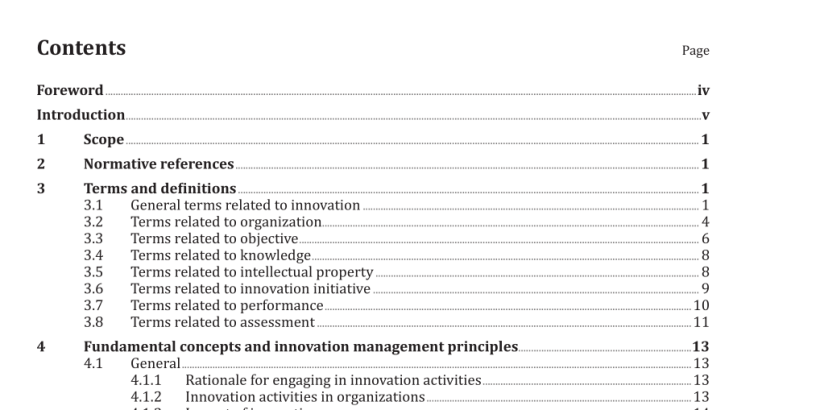BS EN ISO 56000:2021 pdf download – Innovation management — Fundamentals and vocabulary.
1 Scope 1.1 This document provides the vocabulary, fundamental concepts and principles of innovation management and its systematic implementation. It is applicable to: a) organizations implementing an innovation management system or performing innovation management assessments; b) organizations that need to improve their ability to effectively manage innovation activities; c) users, customers and other relevant interested parties (e.g. suppliers, partners, funding organizations, investors, universities and public authorities) seeking confidence in the innovation capabilities of an organization; d) organizations and interested parties seeking to improve communication through a common understanding of the vocabulary used in innovation management; e) providers of training in, assessment of, or consultancy for, innovation management and innovation management systems; f) developers of innovation management and related standards. 1.2 This document is intended to be applicable to: a) all types of organizations, regardless of type, sector, maturity-level or size; b) all types of innovations, e.g. product, service, process, model and method, ranging from incremental to radical; c) all types of approaches, e.g. internal and open innovation, user-, market-, technology- and design- driven innovation activities. This document specifies the terms and definitions applicable to all innovation management and innovation management system standards developed by ISO/TC 279.
2 Normative references There are no normative references in this document.
3.1 General terms related to innovation 3.1.1 innovation new or changed entity (3.2.5), realizing or redistributing value (3.7.6) Note 1 to entry: Novelty and value are relative to, and determined by, the perception of the organization (3.2.2) and relevant interested parties (3.2.4). Note 2 to entry: An innovation can be a product, service, process (3.1.5), model, method, etc.
Note 3 to entry: Innovation is an outcome. The word “innovation” sometimes refers to activities or processes resulting in, or aiming for, innovation. When “innovation” is used in this sense, it should always be used with some form of qualifier, e.g. “innovation activities”. Note 4 to entry: For the purpose of statistical measurement, refer to the Oslo Manual 2018, 4th edition, by OECD/ Eurostat. See Annex B.2 for a comparison between the definitions of innovation by ISO and the OECD/Eurostat. [SOURCE: ISO 9000:2015, 3.6.15, modified by using the term “entity” instead of “object” and by replacing Notes 1 and 2 to entry with the new Notes 1 to 4 to entry.]
3.1.2 management coordinated activities to direct and control an organization (3.2.2) Note 1 to entry: Management can include establishing strategies (3.3.4), policies (3.3.2) and objectives (3.3.3) and processes (3.1.5) to achieve those objectives. Note 2 to entry: Control can include defining roles, appointing authority, assigning tasks, establishing incentives and rewards, and empowering and engaging people. Note 3 to entry: The word “management” sometimes refers to people, i.e. a person or group of people with authority and responsibility for the conduct and control of an organization. When “management” is used in this sense, it should always be used with some form of qualifier, e.g. “top management”. [SOURCE: ISO 9000:2015, 3.3.3, modified by adding “strategies” to Note 1 to entry and by simplifying the text of Note 3 to entry.] 3.1.2.1 innovation management management (3.1.2) with regard to innovation (3.1.1) Note 1 to entry: Innovation management can include establishing an innovation vision (3.3.1.1), innovation strategy (3.3.4.1), innovation policy (3.3.2.1) and innovation objectives (3.3.3.1), and organizational structures and innovation processes (3.1.5.1) to achieve those objectives through planning, support, operations, performance (3.7.1) evaluation (3.8.3) and improvement (3.1.7).
3.1.3.1 management system set of interrelated or interacting elements of an organization (3.2.2) to establish strategies (3.3.4), policies (3.3.2) and objectives (3.3.3) and processes (3.1.5) to achieve those objectives Note 1 to entry: A management system can address a single discipline or several disciplines, e.g. innovation management (3.1.2.1), quality management, financial management, or environmental management. Note 2 to entry: The management system elements include the organization’s structure, roles and responsibilities, planning, support and operation. Note 3 to entry: The scope of a management system can include the whole of the organization, specific and identified functions of the organization, specific and identified sections of the organization, or one or more functions across a group of organizations. Note 4 to entry: This constitutes one of the common terms and core definitions of the high level structure for ISO management system standards. The original definition has been modified by adding “strategies” and by adding examples to Note 1 to entry, by replacing “system” with “management system” and adding “support” to Note 2 to entry.
